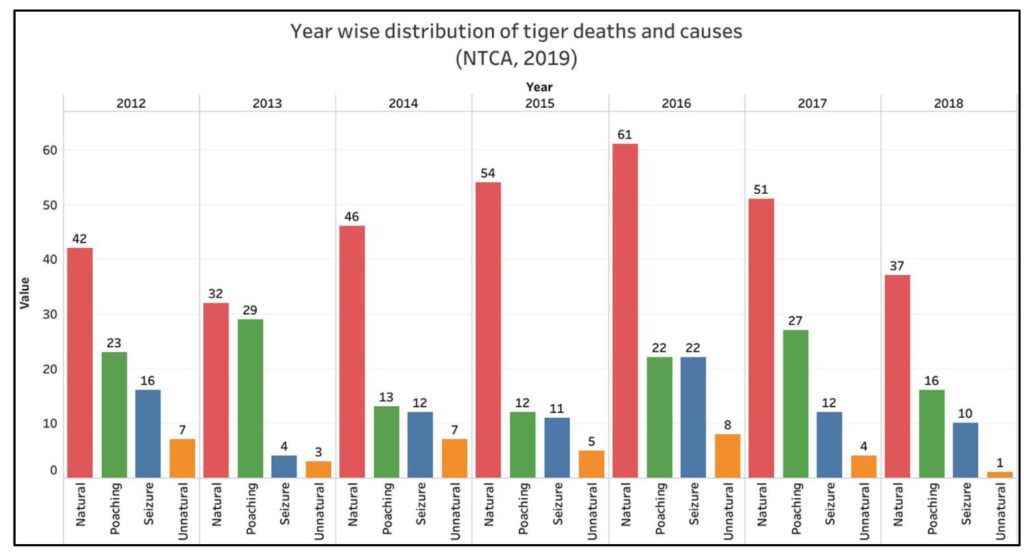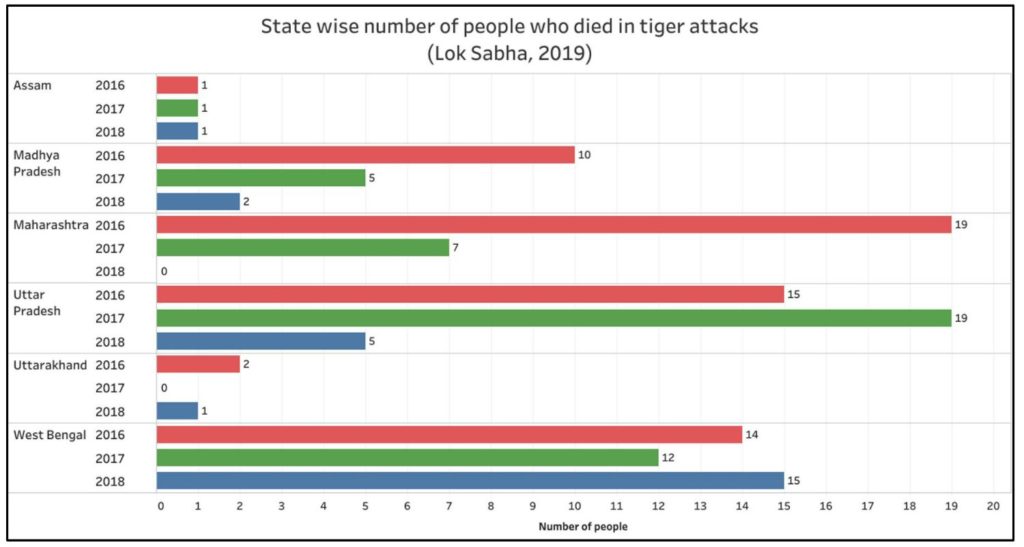[orc]Poaching is one of the major causes of Tiger deaths in the country. Between 2012 & August 2019, 142 tigers have lost their lives due to poaching.
In the previous story on quadrennial tiger census, the total tiger population in India, their region wise distribution based on landscape and ecological significance were discussed.
The human population is multiplying rapidly which requires more space for development and on the other hand, the tiger population has also increased which calls for protection of their habitat in order to sustain it. Many cases of conflicts between the two species have been reported off late thereby putting the conservationists in a quandary since both their needs need to be addressed. In this story, we focus on the human carnivore interaction which ultimately threatens their survival.
Despite the ferocious and fearless reputation of tigers among human beings, reckless poaching of tigers for their skin, claws, bones and canine is prevalent around the globe. The tiger mortality numbers as of 15 August 2019 from the data provided by the National Tiger Conservation Authority indicates that between 2012 and 2018, 9253 people have been arrested in India for wildlife poaching cases. In the last three years alone 2351 people were arrested for the same according to the government’s response in the Lok Sabha.
Of the total 655 tiger deaths since 2012, 21.6% have been due to poaching
A total of 655 tigers have died between 2012 and August 2019. Of these, 323 (49%) have died a natural death. The second biggest cause of tiger deaths is poaching. A total of 142 tigers have died due to poaching during this period. In other words, poaching accounts for 21.6% of the total tiger mortality in India. During the same period, 87 tiger bodies have also been seized. Additional 35 deaths have been reported as unnatural which includes those unnatural cases which cannot be attributed to poaching. For instance, tigers which have died in conflicts and accidents have been included in this category. A total of 68 cases since 2016 are under scrutiny and hence the reasons for their death have not been ascertained.

A look at the annual numbers of tiger mortality shows that the numbers increased from 2013 to 2016. The years 2017 and 2018 show a decline in the number of deaths. On an average, 20 tigers are poached every year. Taking into consideration the cases of poaching and seizures, there were 44 such cases in 2016 (another 8 cases are still under scrutiny), the highest during this period. The number of cases had come down from 39 in 2012 to 23 in 2015. In 2017 and 2018, 39 and 26 cases respectively have been confirmed while 60 are still under scrutiny.
Madhya Pradesh witnessed the largest number of cases of poaching and seizures in the country
A state wise analysis of the numbers revealed that Madhya Pradesh had the largest number of cases of tiger deaths- 142 during the period 2012 to August 2019. Madhya Pradesh has recorded the maximum number of cases of poaching (31) and seizures (12) as well. Maharashtra witnessed 107 tiger deaths during this period. As far as cases of poaching are concerned, after Madhya Pradesh, Karnataka recorded 24 cases while Maharashtra accounted for 21 cases.

If the numbers are scrutinized on the basis of the tiger landscape, the largest number of tiger deaths has taken place in the Central Indian landscape and the Eastern Ghats (288) which holds the largest percentage of tiger population of India. A total of 52 cases of poaching and 35 cases of seizure have been recorded in this region. In the Western Ghats, 180 cases of tiger mortality have been recorded of which 39 are due to poaching and 17 are seizures. 123 tiger deaths have been witnessed in the Shivalik hills and Gangetic plains landscape including 25 poaching and 19 cases of seizure.
The survival of tigers is threatened by a wide plethora of human activities
The practice of slaughtering tigers in the past during the colonial period when it was considered a royal sport and a matter of pride is one major reason behind the steep decline in tiger population from many thousands to a few thousands. Sprawling over the highly diverse landscape of the country, the tigers are mostly solitary and require a large territory. Thus, expansion of railway lines and roads through forests/ tiger reserves has put the tigers in a vulnerable position. The government has disclosed in the Rajya Sabha that 10 tigers were killed in rail and road accidents between 2015 and 2017.
Fragmentation of habitats coupled with deforestation, forest land encroachment and other activities which have led to the deterioration of tiger habitats has further exacerbated the plight of tigers. Even decimation of the prey population affects the carnivore. The ever increasing human population combined with the aforementioned human activities have coerced the tigers to take to human settlements paving the way to conflicts. Loss of human life, predation on livestock and fear instilled among the people result in people resorting to retaliatory killing in spite of the cultural significance attached to tigers.
Between 2016 and 2018, 135 human beings have lost their lives due to tiger attacks
While all this time, the discussion has been focussed on tiger population, humans have also lost their lives in tiger attacks.

Data from the last three (2016-18) years indicates that a total of 135 people have lost their lives to tiger attacks. This number has decreased over the years- from 62 in 2016 to 29 in 2018. West Bengal registered the largest loss of human lives – 41 lives during this three year period. In Uttar Pradesh, 39 people lost their lives in tiger attacks. Other states where tigers have claimed lives include Maharashtra, Assam, Madhya Pradesh, Uttarakhand, Tamil Nadu, Odisha, Karnataka and Rajasthan. Compensation in the form of money is provided to the families of the deceased.
Many families still reside inside the core area of the Critical Tiger habitat (CTH)
Presently, there are 50 tiger reserves in India and a total of 14,441 families have been relocated from the core areas of these reserves since the inception of Project Tiger. Out of the 14,441 families relocated, 5,962 were in Madhya Pradesh and 5,053 in Maharashtra. As per government data, more than 40,000 families still reside inside in the core area of the critical tiger habitat.
The amendment made in 2006 to the Wildlife Protection Act of 1972 led to the establishment of the National Tiger Conservation Authority. The body has been vested with the power to address conflicts, relocation of villagers, lay down normative standards and guidelines for tiger conservation in India, especially the tiger reserves, national parks and sanctuaries- and also facilitate states’ conservation efforts. Wildlife Crime Control Bureau also came into effect in 2007 to curb wildlife trafficking and related crimes. The central government also disburses funds to states that are involved in tiger conservation through Project Tiger. A holistic approach which encompasses both the needs of the people and ecological sustainability can reduce the mortalities on both sides and increase the tiger population.
Featured Image: Tiger deaths in India



1 Comment
Pingback: Poaching accounted for around 22% of Tiger deaths in the last 8 years - Fact Checking Tools | Factbase.us